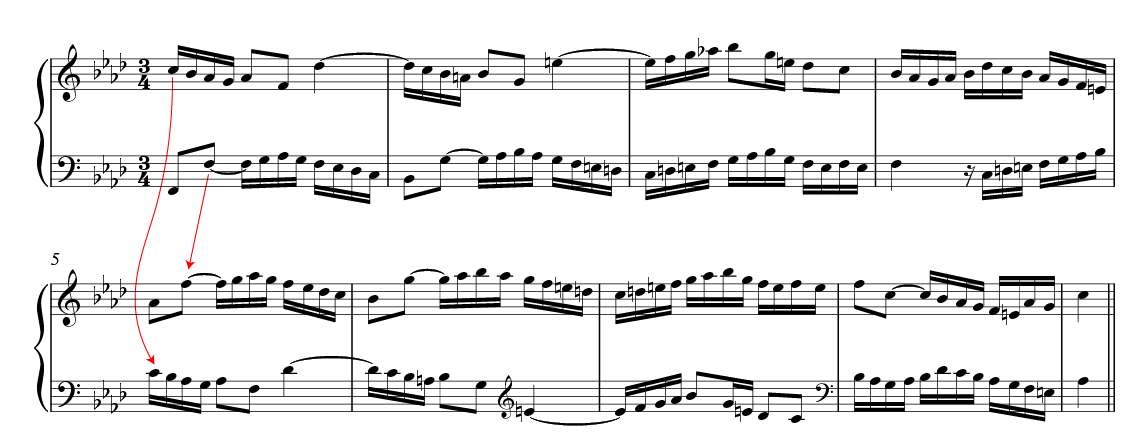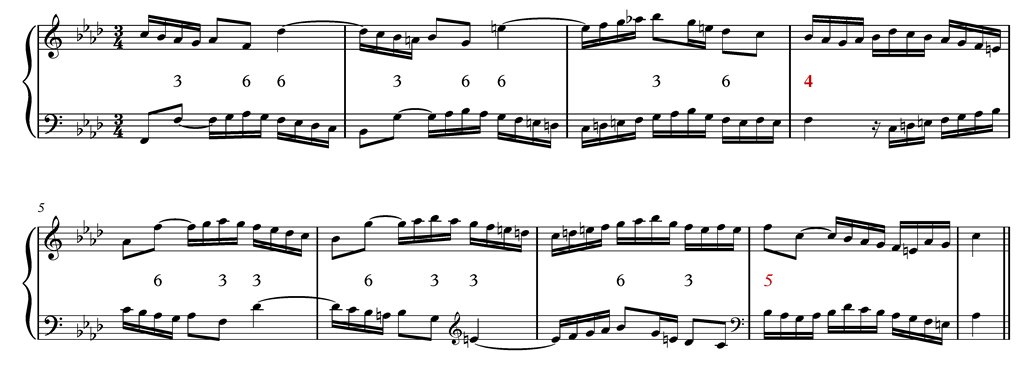Reference : invertible counterpoint
When a polyphonic passage is written so that each voice can be used as a lower, upper, or middle voice, we are using invertible counterpoint. It is called double counterpoint when two voices are involved, and triple and quadruple counterpoint when three or four voices are involved.
Inversion at the octave
Consider the following excerpt from Bach's Invention BWV 780. In bar 5, the voices exchange the content presented in bars 1 through 4:
The inversion Bach uses in this piece in this piece is the most common and is known as inversion at the octave. Counterpoint books give us tables that show how intervals change when they are inverted. Although we may not need them for the inversion at the octave, we will show the table to help understand the tables related to other types of inversions (see Inversion of Intervals for more information).
| intervals in this line: | 2 | 3 | 4 | 5 | 6 | 7 |
| become the corresponding interval in this line: | 7 | 6 | 5 | 4 | 3 | 2 |
These tables can help us find the intervals that may be problematic when inverted. In the case of inversion at the octave, the only problem is with the fourth and fifth intervals. Why is that? Because the fifth - a consonant interval - becomes a fourth, which in counterpoint is considered a dissonant interval.
With this in mind, let's take another look at Bach's Invention. As you can see below, he uses only one fourth interval (bar 4), taking care to use it as an appoggiatura, which is reached by an opposite motion. When the parts are reversed, the fourth becomes a fifth (bar 8):
Inversion at the tenth and the twelfth
In the inversion at the tenth and the twelfth, one of the voices moves an octave while the other moves a tenth or a twelfth. The following examples may help you to visualize this:
Inversion at the octave: upper voice moves down one or more octave and lower voice moves up one or more octave:

Inversion at the tenth: upper voice moves down one octave and lower voice moves up a tenth:

Inversion at the twelfth: upper voice moves down one octave and lower voice moves up a twelfth:

Writing music that is invertible at the tenth or the twelfth presents new problems that do not exist when inverting in the octave.
Inversion at the twelfth
The following table will help us see what becomes of each interval when we use the inversion at the twelfth:
| 2 | 3 | 4 | 5 | 6 | 7 | 8 | 9 | 10 | 11 |
| 11 | 10 | 9 | 8 | 7 | 6 | 5 | 4 | 3 | 2 |
As this table shows, a second becomes an eleventh after inversion, a third becomes a tenth, and so on. The intervals shown in red are those that can cause problems after inversion. The problematic interval in the twelfth inversion is the sixth interval, which becomes a seventh. In other words, a consonant interval (very useful in counterpoint!) becomes dissonant.
Inversion at the tenth
Looking at the tenth table, we see that there are many more problems with this inversion:
| 2 | 3 | 4 | 5 | 6 | 7 | 8 | 9 |
| 9 | 8 | 7 | 6 | 5 | 4 | 3 | 2 |
The most useful intervals - thirds and sixths - become octaves and fifths when inverted! This means that parallel or direct thirds and sixths will become parallel or direct octaves and fifths.
Let's see how Bach uses the inversion at the tenth and the twelfth in the following fragment (measure 44) of Contrapunctus X from The Art of the Fugue:
In measure 66 we see the inversion at the tenth, the higher voice is moved down one octave while the lower voice is moved up a tenth:
How does he avoid problems with thirds and sixths? Notice that he was careful to reach all of them by contrary motion.
In measure 85 the same passage is inverted at the twelfth (the upper voice moves up a twelfth):
How does he avoid the problem of sixths becoming sevenths? He simply doesn't use them in the original, so they don't cause any problems.
Read the the analysis of Contrapuntus X, Canon at the tenth and Canon at the twelfth from the Art of the Fugue and Fugue BWV 885 for some examples of this contrapuntal technique.
In order to get the same passage to invert to the octave, tenth, and twelfth, we must be careful with thirds, sixths, and sevenths:
- reach thirds and sixths by contrary motion to prevent them from becoming parallel or direct fifths and octaves when inverted to the tenth.
- balance the use of imperfect consonances (thirds and sixths) with that of perfect consonances, so that the inversion to the tenth does not sound too empty because of excessive use of perfect consonances.
- be careful with sixths that become sevenths when inverted to the twelfth.
- avoid parallel fourths that become parallel fifths when inverted to the octave.





